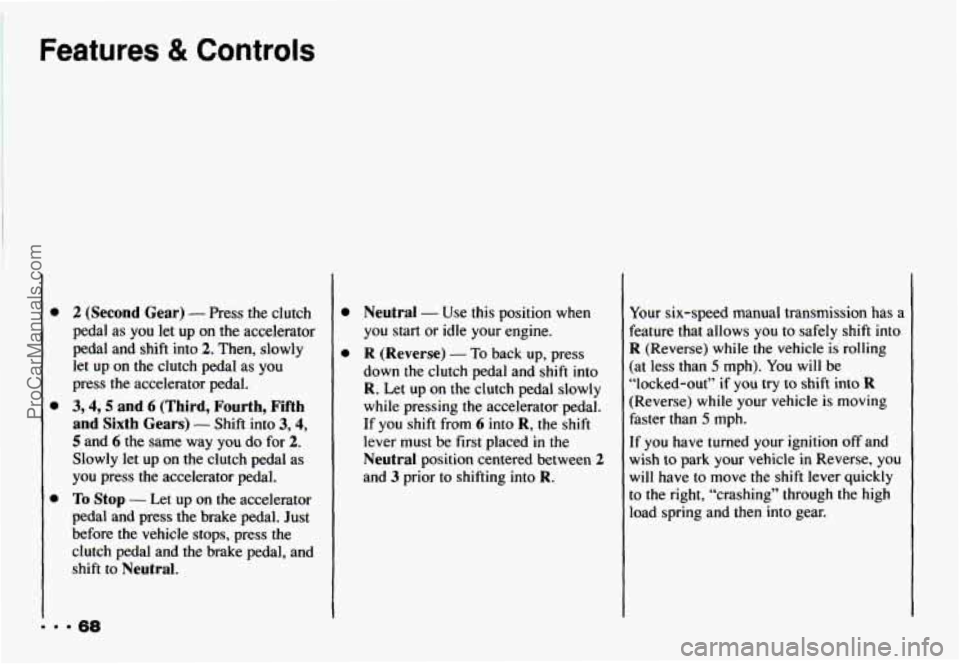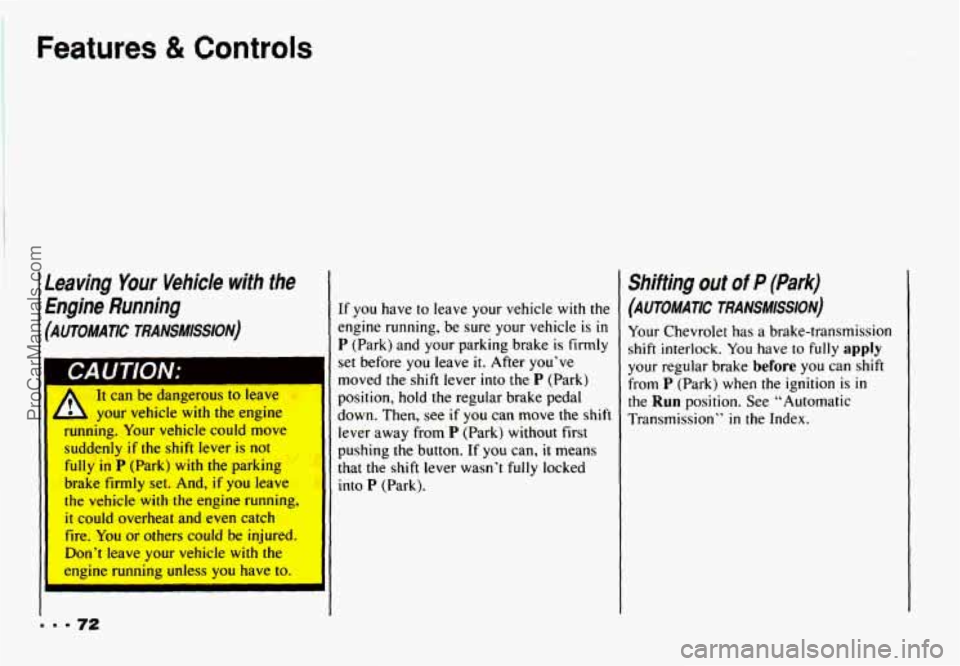Page 67 of 358

I
Ensure the shift lever is fully in P (Park)
range before starting the engine. Your
Chevrolet has a brake-transmission shift
interlock. You have
to fully apply your
regular brakes
before you can shift from
P (Park) when the ignition key is in the
0 R (Reverse)
Use this gear to back up.
11 NOTICE:
I Shifting to K (Reverse) while your
Run position. If you cannot shift out of vehicle is moving forward could
P (Park), ease pressure on the shift lever damage your transmission. Shift to
- push the shift lever all the way into R only after your vehicle is stopped.
P (Park) and also release the shift lever
button on floor shift console models as
you maintain brake application. Then
move the shift lever into the gear you
wish. (Press the shift lever button before
moving
the shift lever on tloor shift
console models.) See "Shifting out of
P (Park)" in this part.
To rock your vehicle back and forth to
damaging your transmission, see "Stuck:
In Sand, Mud, Ice or Snow, If You're"
in the Index.
L get out of snow, ice or sand without
N (Neutral)
In this position, your engine doesn't
connect
with the wheels. To restart when
you're already moving, use
N (Neutral)
only.
Also, use N when your vehicle is
being towed.
639 9
ProCarManuals.com
Page 72 of 358

Features & Controls
0
0
0
2 (Second Gear) - Press the clutch
pedal as you let up on the accelerator
pedal and shift into
2. Then, slowly
let up on the clutch pedal as you
press the accelerator pedal.
3,4,S and 6 (Third, Fourth, Fifth
and Sixth Gears)
- Shift into 3,4,
5 and 6 the same way you do for 2.
Slowly let up on the clutch pedal as
you press the accelerator pedal.
To Stop - Let up on the accelerator
pedal and press
the brake pedal. Just
before the vehicle stops, press the
clutch pedal and the brake pedal, and
shift to
Neutral. Neutral
- Use this position when
you start or idle your
engine.
R (Reverse) - To back up, press
down the clutch pedal and shift into
R. Let up on the clutch pedal slowly
while pressing the accelerator pedal.
If
you shift from 6 into R, the shift
lever must be first placed
in the
Neutral position centered between 2
and 3 prior to shifting into R.
Your six-speed manual transmission has a
feature that allows you to safely shift into
R (Reverse) while the vehicle is rolling
(at less than
5 mph). You will be
“locked-out”
if you try to shift into R
(Reverse) while your vehicle is moving
faster than
5 mph.
If
you have turned your ignition off and
wish to park your vehicle
in Reverse, you
will have to move the shift lever quickly
to the right, “crashing” through the high
load spring and then into gear.
ProCarManuals.com
Page 74 of 358
Features & Controls
fl Limited-Slip Rear Axle
If you have this feature, your rear axle
can give
you additional traction on snow,
mud, ice, sand or gravel. It works like a
standard axle most
of the time, but when
one
of the rear wheels has no traction and
the other does, the limited-slip feature
will allow the wheel
with traction to
move the vehicle.
Purking
Parking Brake
The parking brake uses the brakes on the
rear wheels
To set the parking brake: Hold the brake
pedal down and pull up
on the parking
brake lever.
If the ignition is on, the brake
system warning light
will come on.
J
To release the parking brake: Hold the
brake pedal down. Pull the parking brake
lever up
until you can push in the release
button. Hold the release button
in as you
move the brake lever all the way down.
-
on Driving with the parking bra
cause your rear brakes tc
overheat. You may have to replace
them, and you could also
da: ge
sther parts of your vehicl
ProCarManuals.com
Page 75 of 358

If you are on a hill: See “Parking on
Hills” in the Index. That section shows
how to turn your front wheels.
If you are towing a trailer and are
parking on any
hill: See “Towing a
Trailer”
in the Index. That section shows
what
to do first to keep the trailer from
moving.
Shifting into P (Park)
(AUTOMATIC TRANSMISSION)
It can IX aangerous to get out
- of your vehicle if the shift lever
is not fully in P (Park) with the
parking brake firmly set. Your
vehicle can roll.
If you have left the engine running,
the vehicle can move suddenly.
You
or others could be injured. To
be sure your vehicle won’t move,
when you’re on fairly level ground,
use the steps that follow. If you are
parking on a hill, or if you’re
pulling
a trailer, also see “Parking
on Hills” or “Towing a Trailer” in
the Index.
1. Hold the brake pedal down with your
2. Move the shift lever into P (Park)
right foot and set the parking brake.
position like this:
Hold in the button on the lever,
and push the lever all the way toward the front
of your vehicle.
3. Move the ignition key to LOCK.
4. Remove the key and take it with you.
If you can walk away from your
vehicle
with the ignition key in your
hand, your vehicle is
in P (Park).
ProCarManuals.com
Page 76 of 358

Features & Controls
.eaving Your Vehicle with the
rngine Running
AUTOMATIC TRANSMISSION)
A It can be dangerous to leave
,A your vehicle with the engine
running. Your vehicle could move
suddenly
if the shift lever is not
fully in P (Park) with the parking
brake firmly set. And, if you leave
the vehicle with the engine running,
it could overheat and even catch
fire. You or others could be injured.
Don’t leave your vehicle
with the
I I engine running unless you have to.
If you have to leave your vehicle with the
engine running, be sure your vehicle
is in
P (Park) and your parking brake is firmly
set before you leave it. After you’ve
moved the shift lever into the
P (Park)
position, hold the regular brake pedal
down. Then, see
if you can move the shift
lever away from
P (Park) without first
pushing the button. If you can, it means
that the shift lever wasn’t fully locked
into
P (Park).
Shifting out of P (Park)
(AUTOMATIC TRANSMISSION)
Your Chevrolet has a brake-transmission
shift interlock. You have
to fully apply
your regular brake before you can shift
from
P (Park) when the ignition is in
the Run position. See “Automatic
Transmission”
in the Index.
ProCarManuals.com
Page 80 of 358
Features & Controls
Power Windows (Option)
With power windows, switches on the
door control each window when the
ignition is on or when
RAP is present.
(See “Retained Accessory Power”
in
the Index.)
The switch for the driver’s window has an
Express Down feature. Quickly press and
release
the switch for the driver’s window
and
the window will lower completely.
You can also open this window any
amount by pressing the switch
and
releasing it when the window has
lowered
to the position you want.
Horn
To sound the horn, press either horn
symbol on your steering wheel.
Tilt Wheel
A tilt steering wheel allows you to adjust
;he steering wheel before
you drive.
You can also raise it to the highest level to
give your legs more room when
you exit
md enter the vehicle.
To tilt the wheel, hold the steering wheel
md pull the lever. Move the steering
wheel to a comfortable level, then release
he lever
to lock the wheel in place.
... 76
ProCarManuals.com
Page 88 of 358

Features & Controls
I
I
I'o Get Out of Cruise Control
There are several ways to turn off the
Cruise Control:.
1. Step lightly on the brake pedal or push
the clutch pedal,
if you have a manual
transmission:
OR
2. Move the Cruise switch to OFF.
To Erase Speed Memory
When you turn off the Cruise Control or
the ignition, your Cruise Control set speed
memory
is erased.
Operation of Lights
Although your vehicle's lighting system
(headlights, parking lights,
fog lamps,
side marker lights and taillights) meet all
applicable federal lighting requirements,
certain states and provinces may apply
their own lighting regulations that may
require special attention before you
operate these lights. For example, some
jurisdictions may require that
you operate
your lower beam lights with fog lamps at
all times, or that headlights be turned on
whenever you must use your windshield
wipers.
In addition, most jurisdictions
prohibit driving solely with parking
lights, especially at dawn or dusk. It is
recommended that you check with your
own state or provincial highway authority
for applicable lighting regulations.
ProCarManuals.com
Page 89 of 358

Main Light Control
The main light control is a knob that
works these lights:
0 Headlights
0 Taillights
Parking lights
0 License lights
0 Sidemarker lights
Instrument panel lights
Turn the knob
to SF- to turn on your
headlights and other operating lights.
Turn
the knob to pf to turn on your
parking lights without your headlights,
Turn the knob to
OFF to turn off the
lights.
. .....
Brightness Control
This switch controls the brightness of
your instrument panel lights. Turn the switch to brighten or dim the lights.
If you
turn the switch all the way up to
dv ,
your courtesy lights will come on.
Lights On Reminder
If you turn the ignition Off and leave the
lights on, you
will hear a tone when you
open the driver’s door.
Daytime Running Lights (Canada)
The Canadian Federal Government has
decided that “Daytime Running Lights”
(DRL) are a useful feature,
in that DRL
can make your vehicle more visible to
pedestrians and other drivers during
daylight hours.
DRL are required on new
vehicles sold
in Canada.
Your DRL work
with a light sensor on top
of the instrument panel. Don’t cover
it up.
The front
turn signal lights will come on
in daylight when:
0 The ignition is on
The headlight switch is off, and
The parking brake is released.
ProCarManuals.com